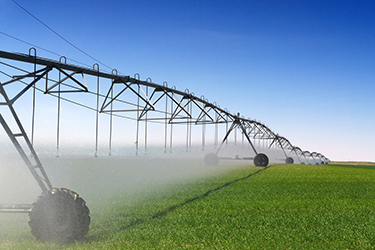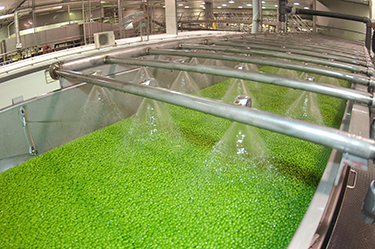|
Subscribe / Renew |
|
|
Contact Us |
|
| ► Subscribe to our Free Weekly Newsletter | |
| home | Welcome, sign in or click here to subscribe. | login |
Environment
| |
 |
September 25, 2014
Is hard water drowning Eastern Washington’s economy?
Landau Associates

Easterson
|
Washington state is a land of contrasts and the “one size fits all” precept has occasionally come under protest when legal or regulatory compliance issues are applied evenly across the state.
The economic, social and political divide is a popular topic with writers who follow the news of the state, but recently issues associated with hard water in Eastern Washington versus soft water in Western Washington are sparking challenges to find a regulatory balance that allows for equitable designs on growth.
Hard water is water that is high in dissolved mineral content, usually in the form of dissolved solids (TDS), which are particles that pass through a 2-micron filter.
In Eastern Washington, particularly throughout the Central Basin, the groundwater has high, naturally occurring levels of TDS that approach regulatory levels established for drinking water. In most groundwater and surface water, these dissolved solids consist of inorganic minerals or salts such as sodium, potassium, calcium, chlorides, nitrate, phosphorus, iron, silica and sulfate.
For the person drawing a glass of tap water, the issue of TDS may be one of aesthetics, but for the manufacturer or community looking to grow crops in Eastern Washington, the issue of complying with existing water quality regulations for TDS becomes a tricky dance with increasingly complicated steps.
Not all in the bag
At the heart of the matter is the practice of land application of process wastewater or beneficial agricultural reuse, which uses the physical, chemical and microbial properties of soil and vegetation to remove contaminants from applied wastewater.
The issue impacts any industry or public agency that produces a wastewater stream, but food processors have been particularly challenged.
Food processing in Washington state is a $15 billion industry that employs 39,000 people, according to the Department of Revenue and Employment Security Department. To land a bag of frozen vegetables or any processed vegetable in our local grocery stores, the food processor must use water in the cleaning, cutting, seasoning, cooking and rapid cooling tasks; water which then becomes part of a waste stream that must be treated prior to discharge to the environment.
In the Central Basin, many of the food processors manage wastewater by mixing it with clean water and using it for crop irrigation on crop lands they own or through partnerships with area farmers. However, all dissolved solids present in the wastewater are not necessarily treated by the crops or retained in the soil column. Therefore, the potential for impacts to groundwater from TDS is a concern.
The Washington Department of Ecology regulates beneficial agricultural reuse of process wastewater through the state waste discharge permit, which allows for wastewater discharge to the ground if it is in compliance with permit conditions.
Issuance of a permit by Ecology or local municipalities requires approval of an engineering report and a crop management plan to ensure that the application of the wastewater does not go beyond the ability of the soil and crops to naturally remove dissolved constituents and thus release high concentrations of dissolved solids to the groundwater.
Herein lies the challenge. If the existing background level of TDS is already high, the land application must be extremely effective in removing TDS to protect groundwater. This can place a burden and sometimes significant expense on the food processor to provide additional pretreatment to the waste stream before applying it to crops as a beneficial reuse of this water resource.
Designs on development
Like communities everywhere, there is a deliberate and sustained effort to entice development to the Central Basin area.
According to the Grant County Economic Development Council, the region offers low electric rates, inexpensive land, a highly trained workforce and a developing infrastructure for transportation and trade. Success stories include new aerospace facilities, agricultural and food processors, data centers, machinery and chemical manufacturing.
While this results in welcomed economic growth and job creation, it also concentrates industries and can place additional stress on existing wastewater treatment facilities tasked with treating wastewater.
Municipal treatment facilities in the Central Basin discharge treated wastewater to the ground surface, so they must be able to demonstrate that these discharges are not impacting groundwater quality. Because municipal treatment facilities do not effectively treat for TDS, incrementally smaller margins are available for supporting additional development.
In Western Washington, by contrast, manufacturers, processors and communities rarely discharge to the ground, but rather to surface waters, which are regulated under National Pollutant Discharge Elimination System permits. Since the west side of the state has relatively low TDS concentration in groundwater and surface water, managing process wastewater to comply with TDS standards is seldom an issue.
he proverbial hard place
Ecology is tasked with enforcing compliance with the existing water quality standards but is also under some pressure to provide consistency in implementing regulations and provide guidance in searching for approaches that allow for maintaining beneficial agricultural reuse for managing wastewater.
High concentrations of TDS primarily influence aesthetic properties of water and are not considered a threat to human health; however Ecology regulates TDS to preserve groundwater quality to the highest and best use, which is drinking water. Washington has adopted the EPA standard of 500 milligrams per liter, which is regulated under Ecology’s anti-degradation rules for groundwater quality.
With existing, high levels of TDS in Eastern Washington’s groundwater, if even small amounts of TDS not naturally removed through beneficial agricultural reuse it can have an impact on groundwater quality.
There are no simple solutions. The state waste discharge permit program requires that permit holders apply “all known, available, and reasonable methods of prevention and treatment” (AKART principles) to a discharge to protect groundwater quality from degradation.
If processors, manufacturers and communities are applying appropriate AKART principles, then it is allowable to change the groundwater quality up to the groundwater standard of 500 mg/L for TDS. Washington law covering groundwater quality standards does allow for some latitude if a “public interest will be served.” Thus the debate ensues: Are regions in Eastern Washington, with existing, high levels of TDS in their groundwater, unfairly burdened when providing for growth and jobs?
Solution in the science?
Ecology has not turned a blind eye to the issue, and has proposed a task force which will start with a literature review of technical resources and an evaluation of how other states are dealing with similar issues.
A representative from Ecology recently participated in a panel discussion, hosted by the Grant County Economic Development Council, on permit issuance and compliance with TDS issues and assured attendees that Ecology wants to engage affected industries to help find solutions that balance the interests of resources, environmental protection and economic development.
The Northwest Food Processors Association has invested in studies to better understand how salts from process wastewater, being applied as beneficial agricultural reuse, are both used and tolerated by various crops. For example, forage crops such as alfalfa and grasses tend to remove more salts from soils treated with process wastewater compared to annual crops.
Also under consideration is the capacity of different soils to retain certain salts by electrostatic attraction, thus preventing the release of TDS to groundwater.
In addition, a thorough understanding and accurate calculation of the leaching requirements is an important consideration when managing salts concentrations in the soils. Leaching refers to the loss of salts from the soil due to excess rain or irrigation.
In Western Washington, high rainfall can wash away nutrients, particularly nitrates, from crop soils. In Eastern Washington, leaching requirements are calculated to keep salts from building up in the soils to levels that impact crop growth. Finding the right irrigation rate and mix of wastewater and clean irrigation water helps maintain TDS in the soil at levels that keep them from impacting groundwater.
Many industries have been proactive in seeking improved and economically viable refinements to primary treatments to reduce levels of TDS. These include practices such as changing cleaning chemicals or cleaning practices to newly developed, greener solutions, isolating specific wastewater streams high in TDS for separate treatment, and/or improving conventional membrane treatments that use electro-dialysis reversal or reverse osmosis to better retain TDS that are incorporated into filterable solids.
A Solution in process
The dialogue for whether changes in permitting requirements can be developed to benefit regions of the state with high background concentrations of TDS in groundwater have just begun. Whether the approach will lend to further division or provide for more cohesion is yet to be seen.
Despite the dividing issues, economic development, whether it happens on the east side or the west side, is good for Washington and the protection of our water resources is good for all Washingtonians.
Cindy Easterson is a senior marketing partner with Landau Associates, a firm that specializes in environmental and geotechnical engineering, environmental permitting and natural resources consulting. Landau Associates has offices in Edmonds, Seattle, Tacoma, Olympia, Spokane and Portland.
Other Stories:
- Passive House finds a permanent home in the Northwest
- Survey: Landau Associates
- Survey: HWA GeoSciences
- Survey: Eco Chemical
- Survey: Environmental Resources Management
- Survey: WISErg Corp.
- Survey: Environmental Sciences Associates
- Survey: Farallon Consulting
- These modular classrooms are not old school
- Local firms invent modules to protect Louisiana coast
- Old mining pond becomes new salmon habitat
- Time to jump on contaminated urban properties?
- Tackling toxics with green chemistry
- How biosolids can curb greenhouse gases
- Lower Duwamish: watershed management poster child?
- Preserving Seattle’s largest forest takes a group effort
- Being green is not just about checking boxes
- Carbon-rich tidal wetlands down, but not out
- Survey: Herrera Environmental Consultants




